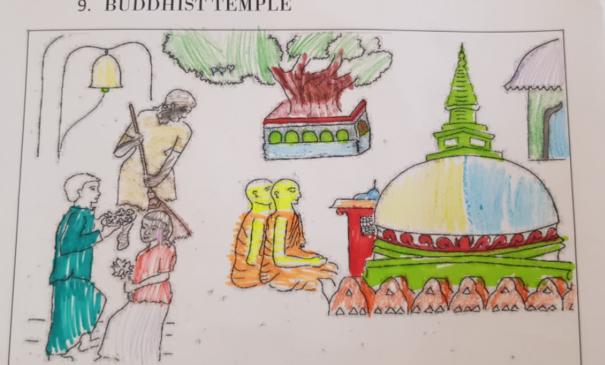GREAT VIRTUES OF THE BUDDHA
By Ven. Dr. K. Sri Dhammananda
The Buddha was an embodiment of all great virtues. In Him were the embodiment of the highest morality (Sila), deepest concentration (Samadhi), and penetrative wisdom (Panna) – qualities unsurpassed and unparalleled in human history. These great noble qualities were mentioned in the sacred texts dealing with the discourses of the Buddha.
Buddhists all over the world recite and contemplate on the nine sublime virtues as contained in the Pali formula, in their daily devotional exercises. Although the Buddha possesses various other noble qualities, here in this formula, only nine are depicted. It is not out of place to mention that in certain other schools of Buddhism, the followers have introduced diverse Buddhas by alluding to some of these great qualities of the Buddha. However, whatever may be the manner used to introduce the Buddha, it is a fact that all those historical Buddhas who appeared in this world, from time to time, were imbued with the same virtues and the same enlightenment. There should, therefore, be no differentiation in paying respects to any particular Buddha, if the designated Buddha is a real Buddha. Consequently, there should be no argument as to which Buddha is more powerful or superior to other Buddha:-

The following verses, in Pali, relate to the nine intrinsic virtues of the Buddha which Buddhist devotees recite when they pay homage to the Buddha:-
“ Itipi So Bhagava Araham Samma-Sambuddho Vijja-Carana-Sampanno Sugato Lokavidu Annutarro Purisa Damma-Sarathi Sattha Deva- Manussanam Buddho Bhagavathi. ”
The authenticity of this passage is unquestionable since it was derived from many important texts of the Tipitaka in the Buddhist canon as well as from amongst the forty methods of Samatha Bhavana – tranquil meditation on Buddhanussati, i.e. Meditation on the virtues of the Buddha.
A brief translation of the Pali passage is as follows:-
“ Such indeed is the Araham – perfect and worthy of homage, Samma sambuddho
– omniscient, Vijja-carana-sampano – endowed with a clear vision and good conduct, Sugato – well done, well-spoken, Lokavidu – wise in the knowledge of the world, Anuttaro Purisa-damma-sarathi – peerless trainer of the untameable ones, Satta- Deva-Manussanam – teacher of gods and men, Buddho – enlightened and showing the path to Enlightenment, Bhagavathi – Blessed.”
- Araham
The Buddha is depicted as an Arahant in five aspects, namely:-
He has discarded all defilements;
He has suppressed all the enemies connected with the eradication of defilements;
He destroyed the spokes of the wheel of existence;
He is worthy of being given offerings and paid homage;
He withheld no secrets in his character or in his teachings.
The Buddha was the greatest figure in human history, with a life perfect, infallible, blameless and spotless. At the foot of the Bodhi tree, He conquered all evil and attained the highest stage of sanctity. He put an end to all sufferings with His attainment of Nibbana. He was the World Honoured One so worthy of homage in all respects. His teaching contains no mysteries or secrets and is like an open book for all to come and see.
- Samma-Sambuddho
The Buddha was designated as Samma-Sambuddho because He comprehended the existence of the world in its proper perspective and He discovered the Four Noble Truths through His own comprehension. Born a Prince, He renounced the world and strove for six long years seeking enlightenment. During this period, He approached all the renowned Teachers of the day and tried all the methods His teachers could teach Him. Having achieved the attainment even equivalent to that of His teachers, He still could not find the elusive goal of enlightenment. Finally, basing His research on rational understanding and treading a middle path, thus departing from the traditional way of legendary religious beliefs and practices, He found the final solution to the universal problems of unsatisfactoriness, conflict, and disappointments ( Dukkha). He discovered the Law of Cause and Effect which He assessed as the reality of the world, thereby becoming the Supreme Enlightened One.
- Vijja-Carana-Sampanno
The term ‘Vijja-Carana-Sampanno’, meant that the Buddha was endowed with a perfect clear vision and exemplary good conduct. It has two significant aspects as indicated in the threefold knowledge and eightfold wisdom. The threefold knowledge is listed as follows:-
Firstly, the Buddha could recall His past birth and traceback His previous existence as well as that of others.
Secondly, apart from being able to recount the past, He had the unique foresight of being able to see into the future and visualized the whole universe at any single moment.
Thirdly, He had that deep penetrating knowledge pertaining to Arahanthood.
On the eightfold wisdom, the Buddha was listed as having the unique gift of insight, the power of performing supernormal feats, a divine ear, the power of reading others ‘ thoughts, various physical powers, ability to recollect past births, a divine eye, and exquisite knowledge pertaining to a life of serene holiness.
With regard to the word “Carana” or good conduct, this aspect is divided into fifteen different categories or types of virtues that were fully imbued in the Buddha. These additional virtues are being classified as a restraint in deed and word, restraint in the absorption of sense effects, moderation in the consumption of food, avoidance of excessive sleep, maintenance of crystal clear vision in faith, the realization of shame in committing evil, the realization of fear in committing evil, thirst for knowledge, energy, mindfulness, and understanding – the four trends pertaining to the material sphere.
Panna and Karuna are reflected as wisdom and compassion, both of which are the basic twins whilst Karuna bestowed him with compassion to be of service to mankind. He realized through his wisdom what is good and what is not good for all beings and through His compassion He led His followers away from evil and misery. The great virtues of the Buddha enabled Him to shower the highest degree of dispensation to brotherhood and sterling qualities to all beings.
- Sugato
The Buddha was also designated as Sugato which meant that His path is good, the destination is excellent and the words and methods used to show the path are harmless and blameless. The Buddha’s path to the attainment of bliss is correct and pure, uncurving, direct, and certain.
His words are sublime and infallible. Many well-known historians and great scientists have commented that the only religious teaching which has remained unchallenged by science and free-thinkers is the Buddha-word.
- Lokavidu
The term Lokavidu is applied to the Buddha as the one with exquisite knowledge of the world. The Master had experienced, known, and penetrated into all aspects of worldly life, physical as well as spiritual. He was the first to make the observation that there were thousands of world-systems in the universe. He was the first to declare that the world was nothing but conceptual. His words, it is regarded as pointless to speculate on the origin and the end of the world or universe. He was of the view that the origin of the world, its cessation and the path to the cessation thereof is to be found within the fathom
– long body – the human being with its perception and consciousness.
- Anuttaro Purisa-Dhamma-Sarathi
Anuttaro means matchless and unsurpassed. Purisa-damma refers to individuals to whom the gift of the Dhamma is to be endowed whereas Sarathi means a leader. These three terms taken together imply an incomparable leader capable of bringing wayward men to the path of righteousness. Amongst those who were persuaded to follow the path of the Dhamma and to shun evil were notorious murderers like Angulimala, Alavaka and Nalagiri, hundreds of robbers, cannibals, and recalcitrants such as Saccake. All of them were brought into the fold of the Dhamma, and some even attained sainthood within their life-time. Even Devadatta, the arch-enemy of the Buddha was rehabilitated by the Buddha through His great compassion.
- Sattha Deva-Manussanam
The Translation of this term is that the Buddha was a Teacher of devas and men. It is to be noted that ‘ devas’ as used in this context refers to beings who, by their own good Karma, have evolved beyond the human stage which is not regarded as the final stage of biological evolution. Devas in the Buddhist context have no connection with ancient traditional theological myths. The Buddha was a remarkable Teacher who was flexible and capable of devising diverse techniques suited to the calibre and different mentalities of devas and human beings. He instructed everyone to lead a righteous way of life. The Buddha was indeed a universal Teacher.
- Buddho
This particular epithet, Buddho, would appear to be a repetition of the second in this category, although it has its own connotation. Buddho means that the Master, being omniscient, possessed extraordinary powers of being able to convince others of His great discovery through His exquisite art of teaching others His Dhamma. His techniques were unsurpassed by any other Teacher. The term Buddho has its secondary meaning translated as ‘ Awakened’ since the ordinary state of man is perpetually in a state of stupor. The Buddha was the first to be ‘awakened’ and to shake off this state of stupor. Subsequently, He convinced others to be awake and to steer clear from the state of lethargic samsaric sleep or stupor.
- Bhagava
Of all the terms used to describe the Buddha, the words ‘ Buddho’ and ‘ Bhagava’, used separately or together as ‘ Buddho Bhagava’ meaning the ‘ Blessed One’ are most popular and commonly used.
Deserving awe and veneration, Blessed is His name. Therefore, the word ‘ Bhagava’ had various meanings as suggested by some commentators. The Buddha was termed ‘ Bhagava’ or the “ Blessed One’ because He was the happiest and most fortunate amongst mankind for having managed to conquer all evils, for expounding the highest Dhamma and for being endowed with supernormal and superhuman intellectual faculties.
These nine great qualities of the Buddha could serve as a subject for meditation if the various interpretations of each particular term are carefully scrutinized and their real intent and the essence grasped and absorbed. The mere utterance of the passage, without its full comprehension, could not be considered effective even as a devotional tract. The best method would be to recite repeatedly and at the same time comprehend the full meaning of these utterances. Whilst so doing, one should also concentrate on these sterling qualities as true virtues to be emulated by all followers of the Buddha.
{"preview_thumbnail":"/sites/default/files/styles/video_embed_wysiwyg_preview/public/video_thumbnails/EDgd8LT9AL4.jpg?itok=nmr60n3y","video_url":"https://youtu.be/EDgd8LT9AL4","settings":{"responsive":1,"width":"854","height":"480","autoplay":1},"settings_summary":["Embedded Video (Responsive, autoplaying)."]}



